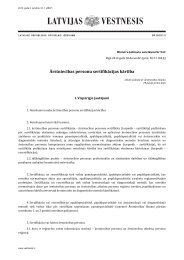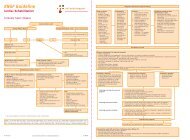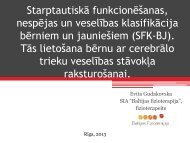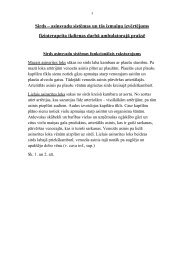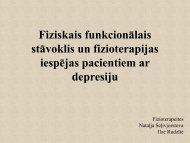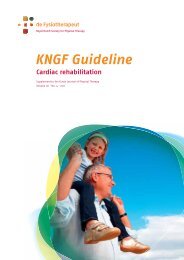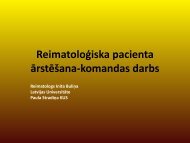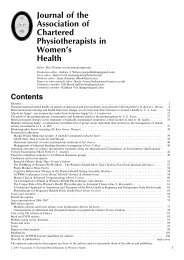Create successful ePaper yourself
Turn your PDF publications into a flip-book with our unique Google optimized e-Paper software.
<strong>Low</strong> <strong>Back</strong> <strong>Pain</strong>: Clinical Practice Guidelines<br />
impairments of body function and body structure, activity<br />
limitations, and participation restrictions<br />
• Identify interventions supported by current best evidence<br />
to address impairments of body function and structure, activity<br />
limitations, and participation restrictions associated<br />
with common musculoskeletal conditions<br />
• Identify appropriate outcome measures to assess changes<br />
resulting from physical therapy interventions in body function<br />
and structure as well as in activity and participation of<br />
the individual<br />
• Provide a description to policy makers, using internationally<br />
accepted terminology, of the practice of orthopaedic<br />
physical therapists<br />
• Provide information for payers and claims reviewers regarding<br />
the practice of orthopaedic physical therapy for<br />
common musculoskeletal conditions<br />
• Create a reference publication for orthopaedic physical<br />
therapy clinicians, academic instructors, clinical instructors,<br />
students, interns, residents, and fellows regarding the<br />
best current practice of orthopaedic physical therapy<br />
The purpose of these low back pain clinical practice guidelines,<br />
in particular, is to describe the peer-reviewed literature<br />
and make recommendations related to (1) treatment<br />
Content experts were appointed by the Orthopaedic Section,<br />
APTA as developers and authors of clinical practice<br />
guidelines for musculoskeletal conditions of the low back<br />
region. These content experts were given the task to identify<br />
impairments of body function and structure, activity limitations,<br />
and participation restrictions, described using ICF<br />
terminology, that could (1) categorize patients into mutually<br />
exclusive impairment patterns upon which to base intervention<br />
strategies, and (2) serve as measures of changes in<br />
function over the course of an episode of care. The second<br />
task given to the content experts was to describe the supporting<br />
evidence for the identified impairment pattern classification<br />
as well as interventions for patients with activity<br />
limitations and impairments of body function and structure<br />
consistent with the identified impairment pattern classification.<br />
It was also acknowledged by the Orthopaedic Section,<br />
APTA content experts that only performing a systematic<br />
search and review of the evidence related to diagnostic categories<br />
based on International Statistical Classification of<br />
Introduction (continued)<br />
Methods<br />
a4 | april 2012 | volume 42 | number 4 | journal of orthopaedic & sports physical therapy<br />
matched to low back pain subgroup responder categories,<br />
(2) treatments that have evidence to prevent recurrence of<br />
low back pain, and (3) treatments that have evidence to influence<br />
the progression from acute to chronic low back pain<br />
and disability.<br />
STATEMENT OF INTENT<br />
These guidelines are not intended to be construed as or to<br />
serve as a standard of medical care. Standards of care are<br />
determined on the basis of all clinical data available for an<br />
individual patient and are subject to change as scientific<br />
knowledge and technology advance and patterns of care<br />
evolve. These parameters of practice should be considered<br />
guidelines only. Adherence to them will not ensure a successful<br />
outcome in every patient, nor should they be construed<br />
as including all proper methods of care or excluding other<br />
acceptable methods of care aimed at the same results. The<br />
ultimate judgment regarding a particular clinical procedure<br />
or treatment plan must be made in light of the clinical data<br />
presented by the patient, the diagnostic and treatment options<br />
available, and the patient’s values, expectations, and<br />
preferences. However, we suggest that significant departures<br />
from accepted guidelines should be documented in the patient’s<br />
medical records at the time the relevant clinical decision<br />
is made.<br />
Diseases and Related Health Problems (ICD) terminology<br />
would not be sufficient for these ICF-based clinical practice<br />
guidelines, as most of the evidence associated with changes<br />
in levels of impairment or function in homogeneous populations<br />
is not readily searchable using the ICD terminology.<br />
Thus, the authors of these guidelines independently<br />
performed a systematic search of the MEDLINE, CINAHL,<br />
and the Cochrane Database of Systematic Reviews (1966<br />
through 2010) for any relevant articles related to classification,<br />
examination, and intervention for musculoskeletal<br />
conditions related to the low back region. The lead author<br />
(A.D.) assigned a specific subcategory (classification, measures,<br />
and intervention strategies for musculoskeletal conditions<br />
of the low back region) to search based upon their<br />
specific area of expertise. Two authors were assigned to<br />
each subcategory and both individuals performed a separate<br />
search, including but not limited to the 3 databases<br />
listed above, to identify articles to ensure that no studies of<br />
relevance were omitted. Additionally, when relevant articles



